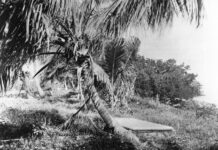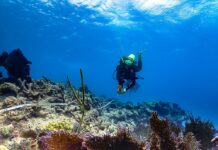
The fish house and processing plant on the bayside of Marathon has a long and storied history, important to tell here — it supplies so much of the seafood prepared at the Original Marathon Seafood Festival, and always has.
It’s a win-win partnership with the festival.
“The Original Marathon Seafood Festival draws people to the Middle Keys,” said Keys Fisheries Vice President Gary Graves, “and, in turn, to our seafood.”
Keys Fisheries handles more lobster in Florida than any other facility — a million pounds in a good year. (2020 is not a good year; more on that later). And, it’s probably first or second in terms of stone crab processing.
“There are probably bigger fish houses on the mainland, but they are handling other fisheries — like snapper and grouper,” Graves said.
In addition to collecting the bounty of the sea from local commercial fishermen, it also functions as a commercial kitchen. The operation is huge and surprising: it makes about 500 Key Lime pies a day and about 500 gallons of soup — lobster chowder, stone crab chowder, shrimp chowder, lobster bisque. Oh, and it also prepares conch ceviche, too, and tartar sauce, mustard sauce, crab cakes and cocktail sauce. Keys Fisheries sells its products to wholesalers, like Whole Foods supermarkets, and restaurants big and small.
Many of the recipes were developed by Keys Fisheries general manager Greg D’Agostino, a former chef, who has headed up the other side of the business for about 15 years now.
“And the Conchwurst, too,” said D’Agostino, “that was my invention.” It’s a sausage made of Conch meat, available exclusively at the Marathon Seafood Festival as well as the restaurant arm of Keys Fisheries. (It’s good. Try it.)
There are trucks coming and going from Keys Fisheries day and night; some of the raw materials such as eggs for the Key Lime pie are trucked in and the finished product is trucked out.
The heart of the operation, of course, is the dockside facility that receives and weighs the catch. The stone crabs are cooked immediately, within an hour of reaching the dock. Then the crabs are flash frozen, then sorted on the following day by size. Why? Why are they cooked so quickly? It’s not about spoilage.
“If it isn’t cooked immediately, the meat sticks to the crab shell. You can’t even scrape it out,” said Graves. “That’s why the fishermen in North Florida stop crab stone fishing during the winter months. If the uncooked claw gets cold, in the 50-degree fahrenheit range, it sticks.”
Temperature is everything when it comes to shipping live lobster, too. Keys Fisheries has one warehouse that’s filled with swimming pools, albeit shallow ones, that are piped with fresh bay water and filtered for sand and muck. The lobster stay in the pools until they are air shipped, said D’Agostino.
“We have to control the water quality and temperature. We essentially put them to sleep and pack them in coolers,” he said, “and they wake up in China about 30 hours later.”
China drives the live lobster market. In recent years, Florida lobster exports to china have ranged from $50 million to $75 million. But, since December, the spread of Coronavirus has had a disastrous effect on the market. Graves and D’Agostino press their lips and shake their heads when the topic comes up. The lobster season, they say, is effectively over even though it doesn’t officially end until March 31. When the captain’s cost of doing business is higher than the wholesale value of the lobster, the boats stay at the dock and the lobster are left to slumber for another year. Keys Fisheries’ diversification then, with the commercial production of seafood products, is invaluable to its bottom line.
Probably the best indication of the facility’s scope is the three-story high racks where crates and pallets are stored. The sheer volume of containers empty containers, ready to be filled, is staggering. Forklifts zoom here and there. At the height of lobster season, Keys Fisheries employs 70 and operates almost around the clock. There are six flash freezers, each the size of a small office, and six ice machines each the size of a truck container.
“We supply all the ice for the seafood festival, too,” D’Agostino. “Any festival, really. Oh, and to the public after the hurricanes. We have generators and we’re also on the same electrical grid as the hospital, so we’re up and running quickly.”
Keys Fisheries has come a long way since its beginnings in 1967. Back then, the fleet consisted of only six boats.
“The whole office was only the size of a closet,” Graves said, “and our docks were only a third of what they are now.”
Keys Fisheries is closed to the public, but the fruits of its labor are available just next door at the restaurant with the same name, the “Clawsablanca” waterfront lounge, and its own retail market stocked with the food it makes, all featuring the plenty of Keys waters.






















